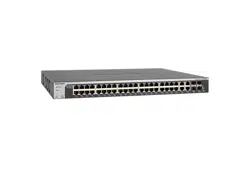Loading ...
Loading ...
Loading ...

Configure Routing
174
ProSAFE 10-Gigabit Smart Managed Switch XS728T and XS748T User Manual
Configure Address Resolution Protocol
The Address Resolution Protocol (ARP) associates a Layer 2 MAC address with a Layer 3
IPv4 address. The switch supports both dynamic and manual ARP configurations. With
manual ARP configuration, you can statically add entries into the ARP table.
ARP is a necessary part of the Internet Protocol (IP) and is used to translate an IP address to
a media (MAC) address, defined by a local area network (LAN) such as Ethernet. A station
that must send an IP packet must learn the MAC address of the IP destination, or of the next
hop router if the destination is not on the same subnet. This is achieved by broadcasting an
ARP request packet, to which the intended recipient responds by unicasting an ARP reply
containing its MAC address. Once learned, the MAC address is used in the destination
address field of the Layer 2 header prepended to the IP packet.
The ARP cache is a table maintained locally in each station on a network. The switch learns
ARP cache entries by examining the source information in the ARP packet payload fields,
regardless of whether it is an ARP request or response. Thus, when an ARP request is
broadcast to all stations on a LAN segment or virtual LAN (VLAN), each recipient can store
the sender’s IP and MAC address in its respective ARP cache. The ARP response, being
unicast, is normally seen only by the requestor, who stores the sender information in its ARP
cache. Newer information always replaces existing content in the ARP cache.
Devices can be moved in a network, which means that the IP address that was at one time
associated with a certain MAC address is now found using a different MAC, or it disappeared
from the network altogether (for example, it was reconfigured, disconnected, or powered off).
This leads to stale information in the ARP cache unless entries are updated in reaction to
new information seen on the network, periodically refreshed to determine if an address still
exists, or removed from the cache if the entry was identified as a sender of an ARP packet
during the course of an ageout interval, usually specified through configuration.
The switch supports 1024 ARP entries. These entries include dynamic and static ARP
entries.
From the Routing > ARP > Advanced menu, you can access pages that are described in
the following sections:
• Display the ARP Cache on page 175
• Add an Entry to the ARP Table on page 176
• Configure the Global Aging-Out Time for ARP on page 177
• Remove an ARP Entry From the ARP Cache on page 178
Loading ...
Loading ...
Loading ...
